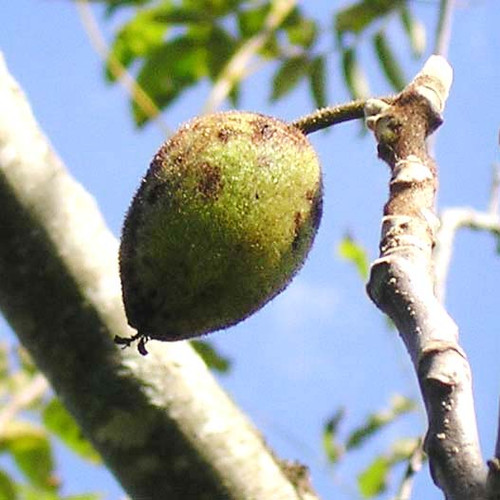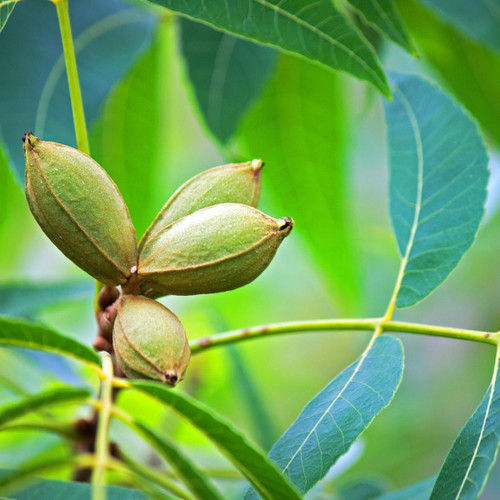Cannot Ship To: AK,CA,HI
Please Read Our Store Policies HERE Before You Order!!
Introduction:
The American Butternut Tree (Juglans cinerea), also known as White Walnut, is a nut-bearing deciduous tree that produces sweet, buttery nuts perfect for baking, snacking, or use in culinary dishes. This large, majestic tree is prized not only for its nuts but also for its valuable timber. With a broad, spreading crown and distinctive ridged bark, the American Butternut Tree adds beauty and shade to your landscape. It thrives in a range of soil types and is well-suited to northern climates, making it a versatile addition to any home orchard or landscape.
Plant Summary:
- Size: Grows to a height of 40-60 feet with a spread of 40-60 feet.
- Foliage: Compound green leaves turn yellow in the fall.
- Flowers/Fruit: Inconspicuous greenish-yellow flowers in spring, followed by oblong, hard-shelled nuts in late summer to fall.
- Growth Habit: Upright with a broad, rounded crown.
- Sunlight: Prefers full sun to partial shade.
- Soil: Thrives in moist, well-drained soils but adapts to a variety of soil types.
- Hardiness: Hardy in USDA Zones 3-7.
- pH Level: Prefers slightly acidic to neutral soils (pH 5.5 to 7.0).
- Pruning: Prune in late winter to remove dead or damaged branches and to shape the tree.
- Pests/Diseases: May be susceptible to Butternut canker and other fungal diseases.
Pollination:
The American Butternut Tree is monoecious, meaning it produces both male and female flowers on the same tree. It is wind-pollinated and typically requires cross-pollination with another Butternut or a closely related species, such as a Black Walnut, to produce a good nut crop. The tree's flowers appear in late spring, followed by oblong, edible nuts in late summer to fall. These nuts are rich in flavor and high in oil content, making them a prized ingredient in many recipes.
Key Benefits:
- Produces rich, buttery nuts that are perfect for snacking or use in baking and cooking.
- Adds beauty and shade to your landscape with its broad, spreading crown.
- Hardy and adaptable, thriving in a variety of soil types and northern climates.
- Valuable timber tree prized for its strong, durable wood.
- Provides food for wildlife with its abundant nut production.
Care Instructions:
- Light: Prefers full sun for optimal nut production but tolerates partial shade.
- Water: Keep soil consistently moist, especially during dry periods.
- Soil Type: Grows best in moist, well-drained soils but adapts to sandy or loamy soils.
- Pollination: Wind-pollinated, but cross-pollination with another Butternut or related tree is needed for optimal nut production.
- Growth Rate: Moderate-growing, reaching maturity in 20-30 years.
- Max Height/Width: Reaches 40-60 feet in height and 40-60 feet in width.
- Pruning: Prune in late winter to shape the tree and remove deadwood.
Why You'll Love It:
The American Butternut Tree is a valuable addition to any landscape, offering both beauty and productivity. Its delicious, buttery nuts are a treat for both humans and wildlife, while its strong wood makes it a valuable timber tree. With its broad, spreading canopy, the Butternut Tree provides excellent shade, making it a perfect choice for large yards, orchards, or naturalized areas. Its adaptability and low-maintenance nature make it a rewarding tree for home gardeners and farmers alike.
Planting Tips:
Plant your American Butternut Tree in early spring or fall in a sunny location with well-drained soil. Dig a hole twice as wide as the root system and plant at the same depth it was growing in the nursery. Water thoroughly after planting and mulch around the base to retain moisture. Regular watering during the first few years will help the tree establish a strong root system.
Flower Color:
Greenish-yellow (inconspicuous)
Plant Class:
Deciduous Nut Tree
Plant Name:
American Butternut Tree
Shipping Details:
Your American Butternut Tree will be shipped as a bare root plant, carefully packaged to ensure it arrives in optimal condition. Bare root plants are shipped during dormancy to promote successful transplanting and establishment in your landscape.
7 Reviews Hide Reviews Show Reviews
-
American Buttnut Tree
I ordered the trees early enough so they could be planted in early spring. Got three nice saplings about two feet tall with very nice rooting. Unfortunately I didn't receiver the plants until mid June with no leaves just dormant buds.. Not a good time to plant. I will re-review this order when it is clear if the trees survive.
-
Arrived in Good, but dormant, shape
Pleased with the tree, will see if it sprouts at this late date (June 28)
-
Trees Look Good
The trees were very well packed and looked good upon arrival. I have them planted. It is too soon to know how they will grow
-
Experiment
They arrived unbroken in good cardboard box. I have planted them watered them. Can't say anymore until I see how they grow. Thank you for the product.
-
LOOKED GREAT ON ARRIVAL
i WAS VERY IMPRESSED WITH HOW WELL THE TREES WERE PACKAGED AND HOW GOOD THEY LOOKED.
-
Very nice
Trees very fresh and hardy.
-
Butternut trees doing well
The trees were well prepared and packed; I planted them almost immediately and they are looking very well, sporting some nice new shoots.








